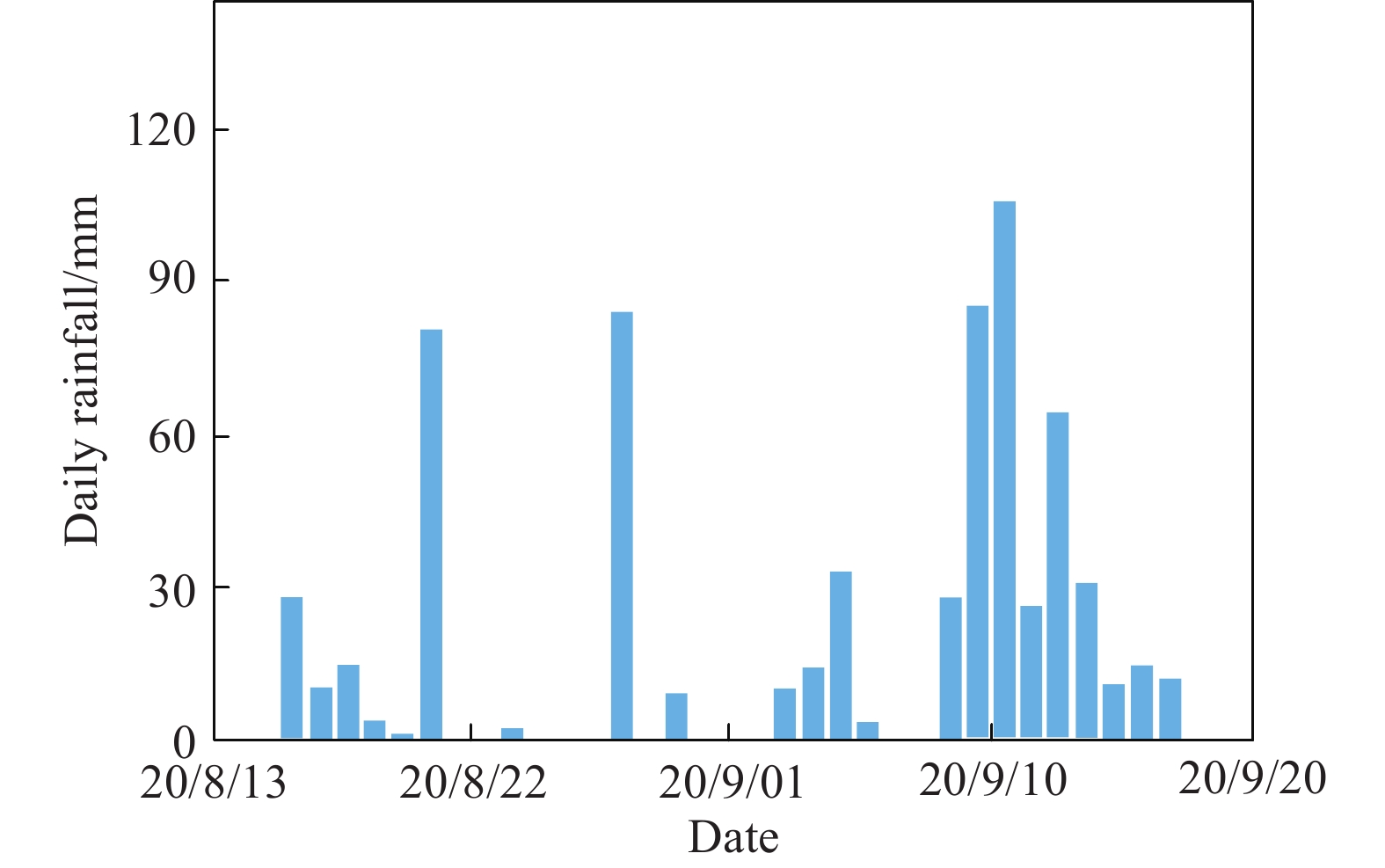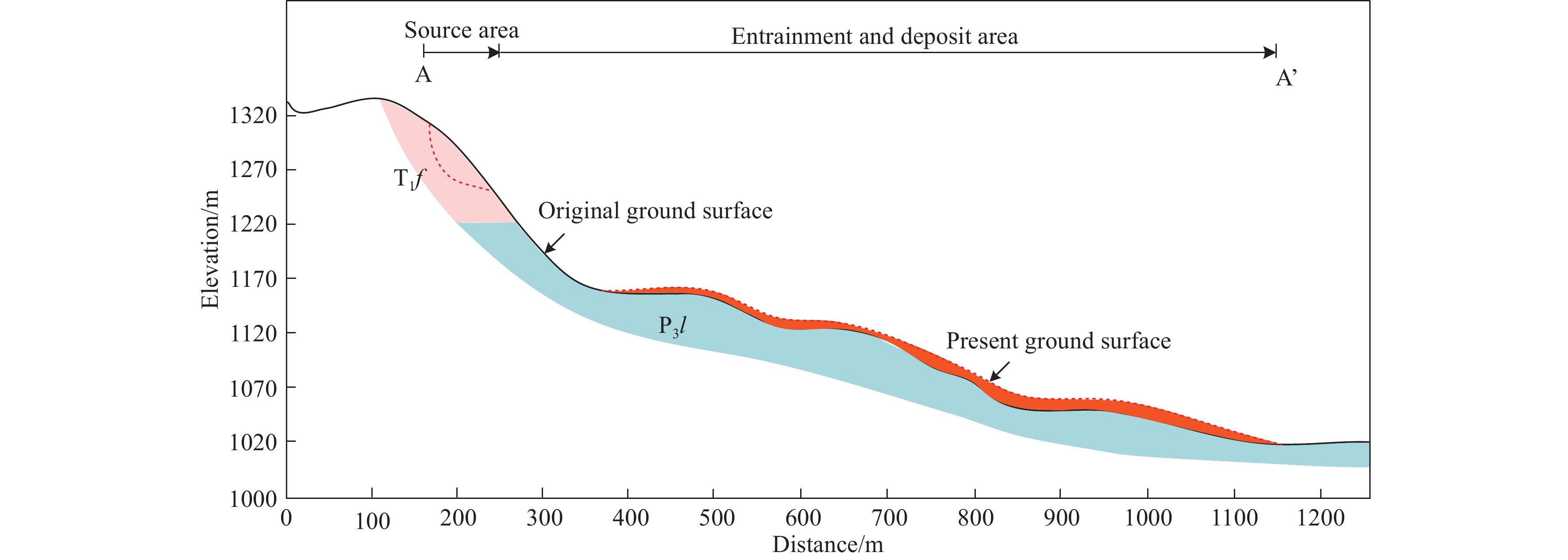| Citation: | Jun Sun, Yu Zhuang, Ai-guo Xing, 2024. Runout prediction of potential landslides based on the multi-source data collaboration analysis on historical cases, China Geology, 7, 263-275. doi: 10.31035/cg2023138 |
Runout prediction of potential landslides based on the multi-source data collaboration analysis on historical cases
-
Abstract
Long runout landslides involve a massive amount of energy and can be extremely hazardous owing to their long movement distance, high mobility and strong destructive power. Numerical methods have been widely used to predict the landslide runout but a fundamental problem remained is how to determine the reliable numerical parameters. This study proposes a framework to predict the runout of potential landslides through multi-source data collaboration and numerical analysis of historical landslide events. Specifically, for the historical landslide cases, the landslide-induced seismic signal, geophysical surveys, and possible in-situ drone/phone videos (multi-source data collaboration) can validate the numerical results in terms of landslide dynamics and deposit features and help calibrate the numerical (rheological) parameters. Subsequently, the calibrated numerical parameters can be used to numerically predict the runout of potential landslides in the region with a similar geological setting to the recorded events. Application of the runout prediction approach to the 2020 Jiashanying landslide in Guizhou, China gives reasonable results in comparison to the field observations. The numerical parameters are determined from the multi-source data collaboration analysis of a historical case in the region (2019 Shuicheng landslide). The proposed framework for landslide runout prediction can be of great utility for landslide risk assessment and disaster reduction in mountainous regions worldwide.
-

-
References
Bellanova J, Calamita G, Giocoli A, Luongo R, Macchiato M, Perrone A, Uhlemann S, Piscitelli S. 2018. Electrical resistivity imaging for the characterization of the Montaguto landslide (southern Italy). Engineering Geology, 243, 272–281. doi: 10.1016/j.enggeo.2018.07.014. Chen LQ, Zhao CY, Li B, He K, Ren CF, Liu XJ, Liu DL. 2021. Deformation monitoring and failure mode research of mining-induced Jianshanying landslide in karst mountain area, China with ALOS/PALSAR-2 images. Landslides, 18, 2739–2750. doi: 10.1007/s10346-021-01678-6. DEM Solutions Ltd. 2019. EDEM 2018 user guide, Edinburgh, UK. Dong JH, Li HJ, Wang YS, Zhang YH. 2021. Characteristics and monitoring-based analysis on deformation mechanism of Jianshanying landslide, Guizhou Province, southwestern China. Arabian Journal of Geosciences, 14, 184. doi: 10.1007/s12517-021-08472-7. Ekström G, Stark CP. 2013. Simple scaling of catastrophic landslide dynamics. Science, 339, 1416–1419. doi: 10.1126/science.123288. Fan XM, Rossiter DG, Westen CJ, Xu Q, Görüm T. 2014. Empirical prediction of coseismic landslide dam formation. Earth Surface Process and Landforms, 39, 1913–1926. doi: 10.1002/esp.3585. Fan XM, Xu Q, Liu J, Subramanian SS, He CY, Zhu X, Zhou L. 2019. Successful early warning and emergency response of a disastrous rockslide in Guizhou province, China. Landslides, 16, 2445–2457. doi: 10.1007/s10346-019-01269-6. Frank F, McArdell BW, Huggel C, Vieli A. 2015. The importance of entrainment and bulking on debris flow runout modeling: examples from the Swiss Alps. Natural Hazards and Earth System Sciences 15, 2569–2583. doi:10.5194/nhess-15-2569-2015 Furman A, Ferré TPA, Warrick AW. 2003. A sensitivity analysis of electrical resistivity tomography array types using analytical element modeling. Vadose Zone Journal, 2, 416–423. doi: 10.2136/vzj2003.4160. Geertsema M, Clague JJ, Schwab JW, Evans SG. 2006. An overview of recent large catastrophic landslides in northern British Columbia, Canada. Engineering Geology, 83, 120–143. doi: 10.1016/j.enggeo.2005.06.028. He K, Chen C, Li B. 2018. Case study of a rockfall in Chongqing, China: movement characteristics of the initial failure process of a tower-shaped rock mass. Bulletin of Engineering Geology and the Environment, 78, 3295–3303. doi: 10.1007/s10064-018-1364-9. Hibert C, Ekström G, Stark CP. 2014. Dynamics of the Bingham Canyon Mine landslides from seismic signal analysis. Geophysical Research Letters, 41, 4535–4541. doi: 10.1002/2014GL060592. Hungr O, McDougall S, Bovis M. 2005. Entrainment of material by debris flows. In: Debris-flow Hazards and Related Phenomena. Springer Praxis Books. Springer, Berlin, Heidelberg. Hungr O, McDougall S. 2009. Two numerical models for landslide dynamic analysis. Computers and Geosciences, 35(5), 978–992. doi: 10.1016/j.cageo.2007.12.003. Hunter G, Fell R. 2003. Travel distance angle for “rapid” landslides in constructed and natural soil slopes. Canadian Geotechnical Journal, 40(6), 1123–1141. doi: 10.1139/t03-061. Ishii Y, Ota K, Kuraoka S, Tsunaki R. 2012. Evaluation of slope stability by finite element method using observed displacement of landslide. Landslides, 9, 335–348. doi: 10.1007/s10346-011-0303-7. Itasca Consulting Group Inc. 2008. PFC3D Particle Flow Code in 3 Dimensions, User’s Guide, Minneapolis. Iverson RM, George DL, Allstadt K, Reid ME, Collins BD, Vallance JW, Schilling SP, Godt JW, Cannon CM, Magirl CS, Baum RL, Coe JA, Schulz WH, Bower JB. 2015. Landslide mobility and hazards: implications of the 2014 Oso disaster. Earth and Planetary Science Letters, 412, 197–208. doi: 10.1016/j.jpgl.2014.12.020. Johnson BC, Campbell CS. 2017. Drop height and volume control the mobility of long-runout landslides on the Earth and Mars. Geophysical Research Letters, 44(12), 12091–12097. doi: 10.1002/2017GL076113. Liu C, Pollard DD, Shi B. 2013. Analytical solutions and numerical tests of elastic and failure behaviors of close-packed lattice for brittle rocks and crystals. Journal of Geophysical Research:Solid Earth, 118(1), 71–82. doi: 10.1029/2012JB009615. Luo H, Xing AG, Jin KP, Xu SM, Zhuang Y. 2021. Discrete Element Modeling of the Nayong Rock Avalanche, Guizhou, China Constrained by Dynamic Parameters from Seismic Signal Inversion. Rock Mechanics and Rock Engineering, 54, 1629–1645. doi: 10.1007/s00603-021-02363-9. Loke MH, Barker RD. 1996. Rapid least-squares inversion of apparent resistivity pseudo sections by a quasi-Newton method. Geophysical Prospecting, 44, 499–524. doi: 10.1111/j.1365-2478.1996.tb00142.x. Ma SY, Xu C, Shao XY, Zhang PF, Liang XH, Tian YY. 2019. Geometric and kinematic features of a landslide in Mabian Sichuan, China, derived from UAV photography. Landslides, 16, 373–381. doi: 10.1007/s10346-018-1104-z. Martorana R, Capizzi P, Alessandro A, Luzio D. 2017. Comparison of different sets of array configurations for multichannel 2D ERT acquisition. Journal of Applied Geophysics, 137, 34–48. doi: 10.1016/j.jappgeo.2016.12.012. McCann DM, Forster A. 1990. Reconnaissance geophysical methods in landslide investigations. Engineering Geology, 29(1), 59–78. doi: 10.1016/0013-7952(90)90082-C. McDougall S, Hungr O. 2005. Dynamic modelling of entrainment in rapid landslides. Canadian Geotechnical Journal, 42(5), 1437–1448. doi: 10.1139/t05-064. Miao T, Liu ZY, Niu YH, Ma CW. 2001. A sliding block model for the runout prediction of high-speed landslides. Canadian Geotechnical Journal, 38, 217–226. doi: 10.1139/t00-092. Morrison IM, Greenwood JR. 1989. Assumptions in simplified slope stability analysis by the method of slices. Géotechnique, 40(4), 655–658. doi: 10.1680/geot.1989.39.3.503. Novellino A, Cesarano M, Cappelletti P, Martire DD, Napoli MD, Ramondini M, Sowter A, Calcaterra D. 2021. Slow-moving landslide risk assessment combining Machine Learning and InSAR techniques. Catena, 203, 105317. doi: 10.1016/j.catena.2021.105317. Perrone A, Lapenna V, Piscitelli S. 2014. Electrical resistivity tomography technique for landslide investigation: A review. Earth-Science Reviews, 135, 65–82. Rapstine TD, Rengers FK, Allstadt KE, Iverson RM, Smith JB, Obryk MK, Logan M, Oisen MJ. 2020. Reconstructing the Velocity and Deformation of a Rapid Landslide Using Multiview Video. Journal of Geophysical Research:Earth Surface, 125, e2019JF005348. doi: 10.1016/j.earscirev.2014.04.002. Rezaei S, Shooshpasha I, Rezaei H. 2019. Reconstruction of landslide model from ERT, geotechnical, and field data, Nargeschal landslide, Iran. Bulletin of Engineering Geology and the Environment, 78(5), 3223–3237. doi: 10.1007/s10064-018-1352-0. Samodra G, Ramadhan MF, Sartohadi J, Setiawan MA, Sukmawijaya S. 2020. Characterization of displacement and internal structure of landslides from multitemporal UAV and ERT imaging. Landslides, 17, 2455–2468. doi: 10.1007/s10346-020-01428-0. Scheidegger AE. 1973. On the prediction of the reach and velocity of catastrophic landslides. Rock Mechanics, 5, 231–236. doi: 10.1007/BF01301796. Schöpa A, Chao WA, Lipovsky BP, Hovius N, White RS, Green RG, Turowski JM. 2018. Dynamics of the Askja caldera July 2014 landslide, Iceland, from seismic signal analysis: precursor, motion and aftermath. Earth Surface Dynamics, 6, 467–485. doi: 10.5194/esurf-6-467-2018. Sharma PS. 1997. Environmental and engineering geophysics. Cambridge University Press, 78–79. Shi C, Zhang YL, Xu WY, Zhu QZ, Wang SN. 2013. Risk analysis of building damage induced by landslide impact disaster. European Journal of Environmental and Civil Engineering, 17(S1), 126–143. doi: 10.1080/19648189.2013.834590. Stein S, Wysession M. 2003. An introduction to seismology, earthquakes, and earth structure. John Wiley & Sons. Strom A. 2006. Morphology and internal structure of rockslides and rock avalanches: grounds and constraints for their modeling. In: Evans, S. G., Mugnossa, G. S., Strom, A., Hermanns, R. L. (Eds.), Landslides From Massive Rock Slope Failure, NATO Sciences Series, IV. Earth and Environmental Sciences, 49, 305–326. doi: 10.1007/978-1-4020-4037-5_17 Szczygieł J, Mendeck, M, Hercman H, Wroblewski W, Glazer M. 2019. Relict landslide development as inferred from speleothem deformation, tectonic data, and geoelectrics. Geomorphology, 330, 1160–128. doi: 10.1016/j.geomorph.2019.01.017. Thompson N, Bennett MR, Perfort N. 2009. Analyses on granular mass movement mechanics and deformationwith distinct element numerical modeling: implicationsfor large-scale rock and debris avalanches. Acta Geotechnica, 4, 233–247. doi: 10.1007/s11440-009-0093-4. Tomás R, Abellán A, Cano M, Riquelme A, Tenza-Abril AJ, Baeza-Brotons F, Saval JM, Jaboyedoff M. 2017. A multidisciplinary approach for the investigation of a rock spreading on an urban slope. Landslides, 15, 199–207. doi: 10.1007/s10346-017-0865-0. Xu L, Dai FC, Tham LG, Zhou YF, Wu CX. 2012. Investigating landslide-related cracks along the edge of two loess platforms in northwest China. Earth Surface Processes and Landforms, 37(10), 1023–1033. doi: 10.1002/esp.3214. Yalcinkaya E, Alp H, Ozei O, Gorgun E, Martino S, Lenti L, Bourdeau C, Bigarre P, Coccia S. 2016. Near-surface geophysical methods for investigating the Buyukcekmece landslide in Istanbul, Turkey. Journal of Applied Geophysics, 134, 23–35. doi:10.1016/j.jappgeo.2016.08.012 Yin YP, Xing AG, Wang G, Feng Z, Li B, Jiang Y. 2017. Experimental and numerical investigations of a catastrophic long-runout landslide in Zhenxiong, Yunnan, southwestern China. Landslides, 14, 649–659. doi: 10.1007/s10346-016-0729-z. Zhang YB, Xing AG, Jin KP, Zhuang Y, Bilal M, Xu SM, Zhu YQ. 2020. Investigation and dynamic analyses of rockslide-induced debris avalanche in Shuicheng, Guizhou, China. Landslides, 17, 2189–2203. doi: 10.1007/s10346-020-01436-0. Zhu YQ, Xu SM, Zhuang Y, Dai XJ, Lv G, Xing AG. 2019. Characteristics and runout behaviour of the disastrous 28 August 2017 rock avalanche in Nayong, Guizhou, China. Engineering Geology, 259, 105154. doi: 10.1016/j.enggeo.2019.105154. Zhuang Y, Xing AG, Cheng QG, Li DS, Zhao C, Xu C. 2019. Characteristics and numerical modeling of a catastrophic loess flow slide triggered by the 2013 Minxian–Zhangxian earthquake in Yongguang village, Minxian, Gansu, China. Bulletin of Engineering Geology and the Environment, 79, 439–449. doi: 10.1007/s10064-019-01542-x. Zhuang Y, Xing AG, Leng YY, Bilal M, Zhang YB, Jin KP, He JY. 2021. Investigation of Characteristics of Long Runout Landslides Based on the multi-source Data Collaboration: A Case Study of the Shuicheng Basalt Landslide in Guizhou, China. Rock Mechanics and Rock Engineering, 54, 3783–3798. doi: 10.1007/s00603-021-02493-0. Zhuang Y, Piazza N, Xing AG, Christen M, Bebi P, Bottero A, Stoffel L, Glaus J, Bartelt P. 2023a. Tree Blow-Down by Snow Avalanche Air-Blasts: Dynamic Magnification Effects and Turbulence. Geophysical Research Letters, 50, e2023GL105334. doi: 10.1029/2023GL105334. Zhuang Y, Xu Q, Xing AG, Bilal M, Gnyawali KR. 2023b. Catastrophic air blasts triggered by large ice/rock avalanches. Landslides, 20, 53–64. doi: 10.1007/s10346-022-01967-8. -
Access History

-
Figure 1.
Framework for the landslide runout prediction.
-
Figure 2.
(a) Locations of the landslide disasters in Guizhou, China. (b) Overview of the Shuicheng landslide.
-
Figure 3.
Dynamic and deposit characteristics of the Shuicheng landslide (after Zhang YB et al., 2020 and Zhuang Y et al., 2021). a–Seismic signal analysis results; b–e–evolution process of the Shuicheng landslide simulated by DAN3D; f–g–ERT results testing the modeled landslide deposits. In the ERT inversion images, white dashed lines represent the hypothetical boundary from ERT results, and red dashed lines represent DAN3D simulated results.
-
Figure 4.
View of the Jianshanying landslide. a–Jianshanying mountain in Shuicheng, Guizhou, China; b–shows the landslide region and zone division; c–the potential landslide at the top of mountain.
-
Figure 5.
Daily rainfall of the study area.
-
Figure 6.
Longitudinal profile of the Jianshanying landslide.
-
Figure 7.
Sliding process of the Jianshanying landslide simulated by Dan3D.
-
Figure 8.
Maximum velocity contour of the Jianshanying landslide.
-
Figure 9.
Runout prediction of the potential landslide.
-
Figure 10.
Disaster scope of the potential landslide.





 DownLoad:
DownLoad:








